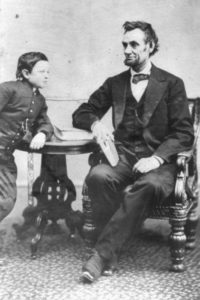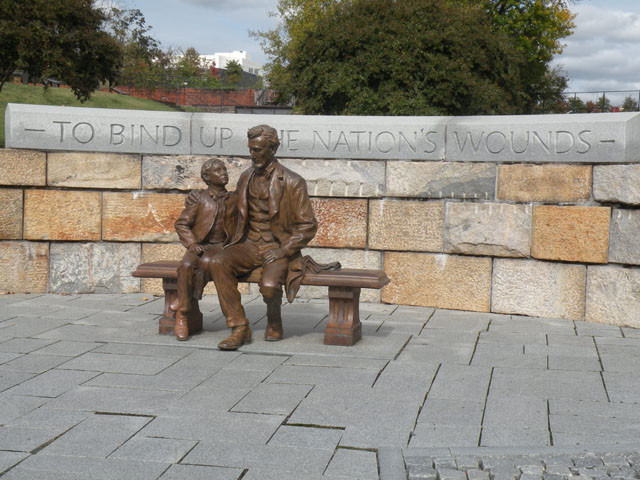 On April 4, 1865, President Abraham Lincoln took his son Tad into the city of Richmond, Virginia. The city had fallen the day before into Union hands two days before. It was Tad’s 12th birthday.
On April 4, 1865, President Abraham Lincoln took his son Tad into the city of Richmond, Virginia. The city had fallen the day before into Union hands two days before. It was Tad’s 12th birthday.
Tad was born Thomas Lincoln III, in 1853. He was named after Lincoln’s somewhat estranged father, but everyone called him Tad because as an infant he had a large head and was as wiggly as a tadpole. Tad was born with a partial cleft palate that was not externally noticeable but gave him a lisp and made his speech difficult to understand. He and Willie ran ramshackle over the White House until Willie’s premature demise, after which Lincoln doted on Tad to the extreme.
In late March 1865, General Grant had invited Lincoln to City Point (near Petersburg), to which Lincoln immediately accepted. He was not alone; Mary insisted on joining him, so a party including Tad Lincoln, a maid, a bodyguard, and a military aide boarded the River Queen on March 23 for the trip. Son Robert, now an adjunct to Grant’s army, met them on their arrival the next evening. Lincoln took time to visit the troops and confer with Generals Grant and Sherman and Admiral David Porter. Overall it was a restful but productive visit. That changed when Mary Lincoln flew into a jealous rage at seeing General Ord’s wife riding “too close” to her husband, after which Lincoln sent Mary back to Washington. Soon after her departure, however, the Union captured Richmond, which the Confederate leadership had abandoned. She insisted on returning, this time bringing a large entourage that included her ex-slave dressmaker, Elizabeth Keckley, who had been born in nearby Petersburg.
During Mary’s absence, Lincoln took Tad into Richmond. After landing at the docks, Lincoln and Tad walked the mile or so to the Confederate White House that had served until a few days earlier as Jefferson Davis’s office. Surrounding him along the way were hundreds of ex-slaves who wanted to see the “Great Emancipator,” while anxious white southerners stared suspiciously from their windows.
Confederate President Jefferson Davis and his cabinet had fled the city on April 2nd, boarding the last open railroad line further south. Retreating soldiers set fire to bridges, the Richmond armory, and various supply warehouses. Untended, the fires grew out of control and large parts of Richmond were destroyed. The city was surrendered to Union officers the next day. Since Lincoln was relatively nearby, he chose to visit the former Confederate capital, bringing along Tad. For Tad, this was a best birthday celebration ever, as he enjoyed wearing military uniforms and “playing soldier,” much to the chagrin of the White House staff and cabinet.
A statue of Lincoln and Tad was erected in modern times at the site of Tredegar Iron Works.

Before heading back to Washington, Lincoln visited the Depot Field Hospital at City Point. Over the course of a full day he shook the hands of more than 6,000 patients, including a few sick and wounded Confederate soldiers. Feeling the pressure of business, Lincoln left City Point to return to Washington on the evening of April 8. The next day, Lee surrendered his army to General Ulysses S. Grant, effectively ending the war.
A week later Lincoln would die from an assassin’s bullet.
Tad survived the trauma of his father’s assassination and his mother’s near-insanity only to die at 18 years old when a common cold developed into severe damage to his lungs. Of Abraham and Mary’s four children, only the oldest, Robert, would live to adulthood.
[Adapted in part from my book, Lincoln: The Man Who Saved America]
[Photo Credit of Lincoln and Tad statue: Riverfront.com]
David J. Kent is an avid science traveler and the author of Lincoln: The Man Who Saved America, in Barnes and Noble stores now. His previous books include Tesla: The Wizard of Electricity (2013) and Edison: The Inventor of the Modern World (2016) and two e-books: Nikola Tesla: Renewable Energy Ahead of Its Time and Abraham Lincoln and Nikola Tesla: Connected by Fate.
Check out my Goodreads author page. While you’re at it, “Like” my Facebook author page for more updates!











Just curious, but what was Linciln’s health like at this point in his life?
That’s a topic of some debate. Mostly he was worn down from the dual stresses of the Civil War and his wife (she was distraught by the death of their son Willie in 1862, plus a constant weight on Lincoln’s shoulders due to her misuse and abuse of government funding).
There are a very small number of people who have argued that he may have had some life-threatening disease like cancer, but these are pretty much out of the mainstream of credibility. There was also speculation that he might be suffering from Marfan syndrome or syphilis, but these have been pretty well debunked. He did have malaria once or twice and a case of smallpox right after the Gettysburg Address that put him bed for a couple of weeks.
But mainly I think he was just physically and mentally worn out. That said, he did make the extended trip to City Point and the visit to Richmond, so he still had legs under him.
I think I’d read something a long time back about the Marfan syndrome theory. It seemed rather a reach. I didn’t know about the Malaria, which I would imagine was recurrent issue. The nature of Tad’s death had me thinking about the stress combined with the unhealthy conditions that must have existed as the aftermath of protracted warfare. Considering the state of medicine at the time and Lincoln’s up close and personal visits, I was wondering how his own health had fared. Regardless, I’m impressed at his resilience.
The area between the White House and what is now the reflecting pool/Lincoln Memorial was pretty much a disease-infested swamp back then. Malaria wasn’t uncommon and typhoid was almost ubiquitous (Willie [not Tad] probably died of typhoid). The fact that tens to hundreds of thousands of soldiers bivouacked and dumped their waste upstream of the White House, not to mention the hogs roaming the muddy streets, increased the incidences of disease. It’s one of the reasons Lincoln took his family during the summers of 1862-64 up to the Soldiers’ Home (now open as the Lincoln Cottage) about 3 miles north of the White House. The air was a lot better to breath up there.